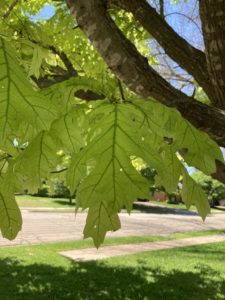When school teachers make an assignment for students to memorize a poem to recite (possibly, teachers don’t actually do this any more), kids often rely on a short and sweet poem by Joyce Kilmer
TREES
I think that I shall never see
A poem lovely as a tree.
A tree whose hungry mouth is prest
Against the earth’s sweet flowing breast;
A tree that looks at God all day,
And lifts her leafy arms to pray;
A tree that may in Summer wear
A nest of robins in her hair;
Upon whose bosom snow has lain;
Who intimately lives with rain.
Poems are made by fools like me,
But only God can make a tree.
Yes, it’s a real poem by a real person. Kilmer was a respected poet in his time, but not particularly remembered these days (except for “Trees”). He was killed in battle in World War I.
I’ve been thinking about the trees, these days, as we are looking around the neighborhood. One of the most-respected horticulturists in Texas publishes a gardening book periodically, and has a weekly gardening blog targeting Texas’ plants. He and other plant specialists are looking carefully at Texas plant life this spring, given the epic ice and snow we had in February. They are saying “Give the trees some time.” Our trees have seemed to say, “Oh, we’re fine. Just fine.” They’ve leafed out and seem quite healthy. One of them is much healthier.

Is this a healthy-looking tree or what!?! it’s a white oak and stands next to our driveway, in a side yard. For years it grew steadily, leafed out each spring, and turned a bright, beautiful yellow each fall. It was the first tree whose leaves changed each fall, standing out among the trees that were still green. Then, a couple of years ago, it didn’t look so great. The leaves weren’t as bright when fall came. I thought well, maybe every now and then, it has an off season. Then, the next year, it looked even less great.
Imagine that this (beautiful) leaf has five or six dime-sized brown spots on it. That’s what all the leaves looked like late last summer. I pulled a spray of leaves from the tree and took it to a nursery and asked for a tree expert. His first response was “It needs iron.” He said that I should sprinkle iron on the ground at the outer edges of the span of the tree. “Do that now, in the fall,” he said. “And then do it again in the spring. I bought a big bag of iron (“big” was the only size available), and carefully spread it around, as directed. And watered it in. Then, early in the spring, I did it again. And look what happened. A full, beautifully leafed-out tree.
The tree looks outstanding right now, and I’m anticipating that it will look all golden in October. And, if I need to spend time each fall, for the rest of my life, sprinkling iron around the edges of the tree’s span, that’s something I can do. (Or something I can ask someone like Kevin or April or Peter to do.)
For you shall go out in joy
and be led forth in peace;
the mountains and the hills before you
shall break forth into singing,
and all the trees of the field shall clap their hands.
Isaiah 55:12 (English Version)
One of my favorite verses.

